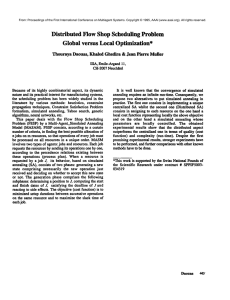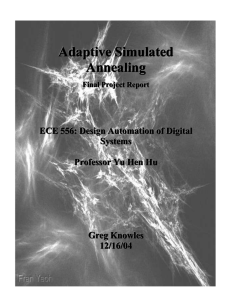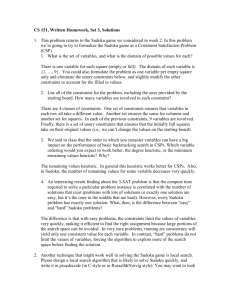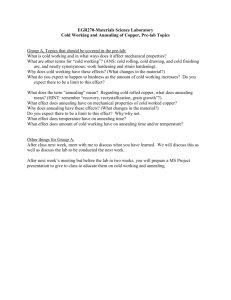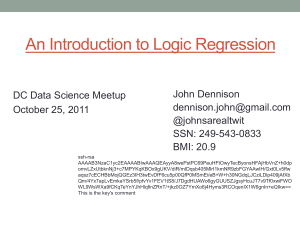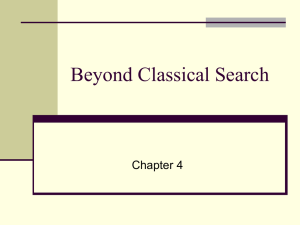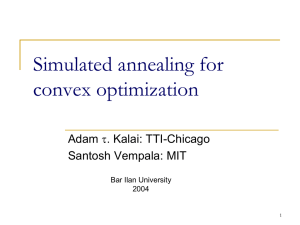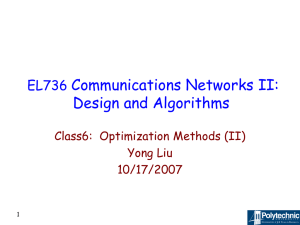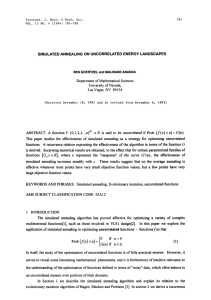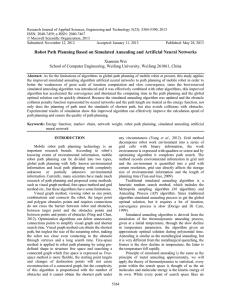Simulated annealing presentation in pptx
advertisement
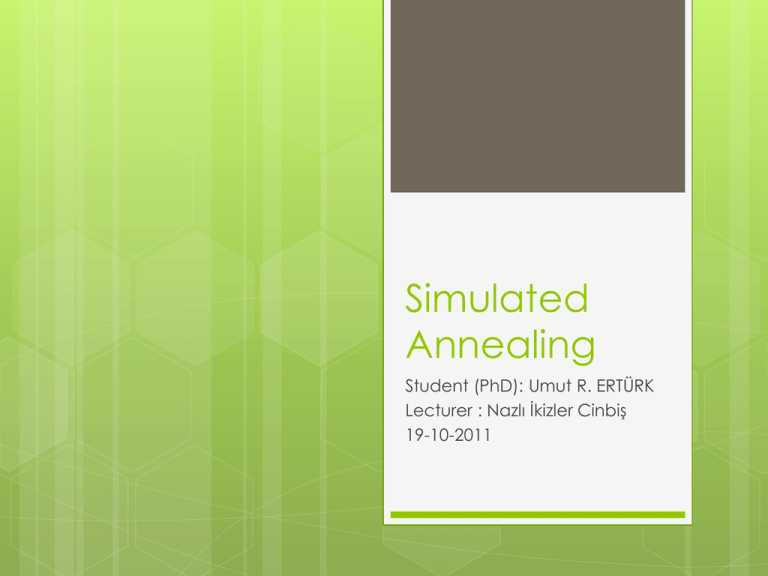
Simulated Annealing Student (PhD): Umut R. ERTÜRK Lecturer : Nazlı İkizler Cinbiş 19-10-2011 Content: Statistical Mechanics NP-Complete Problems Heuristics Markov Chain Monte Carlo Simulated Annealing Implementation Example Strengths-Weaknesses Statistical Mechanics Ever heard Leica? Thousands of $ But WHY? Wetzlar was never bombed during WW2?!!! Statistical Mechanics As there are billions of atoms, only the most probable behaviour of them observed in experiments Position of an atom is probabilistically; −∆𝐸 𝑇 𝑒 × 𝑘𝐵 Where ∆E is the energy change, T is temperature and kB is Boltzmann constant Which means higher the temperature higher the probability range, higher the energy change lower the probability range How can one arrange them to form low energy crystal forms? In nature molecules tend to be in a lower energy state. Nature uses the formula above not a linear one (Kirkpatrick, S.) NP Complete problems Nondeterministic polynomial time problems Which can be verified in polynomial time Complexity is 𝑛𝑘 There is not an exact solution but a set of probable solutions. Impossible to find with classical search methods. Heuristics Problem specific solutions Two strategies Divide and conquer Pieces must be re-arranged after every divide Iterative Search/rearrange until a better configuration is found Usually not to get stuck in local minimums, generate random configurations and save best results globally Markov Chain Next state only depends on the current state No Memories! Probabilistic approach Randomness From wiki Markov Chain Monte Carlo Monte Carlo method takes place when the exact solution is not possible to find with deterministic solutions Special Markov chain model Which has the desire to be in a equilibrium state Simulated Annealing Using thermodynamic rules and statistical mechanics for solving NPC problems with heuristics first introduces in 1953 by Metropolis et al. (Kirkpatric, S. p.2) Implemented in 1983 by S. Kirkpatric for solving complex problems; Travelling Salesman and Microprocessor wiring problems Actually it is a mixture of all the subjects mentioned in this slideshow earlier. Simulated Annealing Let’s have such a decreasing function How can we find the global minimum? Increase x slowly and find the minimum y How slowly? How many sampling points? Simulated Annealing What about this one? And this one? Simulated Annealing Definition : SA is a random search technique which exploits an analogy between the way in which metal cools and freezes into a minimum energy crystalline (Busetti, F.). For solving combinatorial minimization problems (Teukolsky, SA) NP complete problems (Teukolsky, SA) Simulated Annealing Methodology: Markov C. Monte C. (take random steps until reaching equilibrium) Starts with an initial state and temperature (analogy from thermodynamics) Randomly changing the state, creates a new state Compares energies of the new state and the current state If the new state has less energy(analogy) OR it’s probability function (𝑒 −∆𝐸 𝑇 ) is less than a random value Accept the new state as the current state heuristically iterative and divide-and-conquer (for each temperature creates a new state) by its nature (Kirkpatrick, S.) Simulated Annealing The condition below actually accepts a state even if it increases the Energy of the function OR it’s probability function (𝒆 than a random value But WHY? −∆𝑬 𝑻 ) is less Simulated Annealing 1. 2. 3. 4. Taken from (Teukolsky, SA, p.445) To make use of the Metropolis algorithm for other than thermodynamic systems, one must provide the following elements: A description of possible system configurations. A generator of random changes in the configuration; these changes are the options” presented to the system. An objective function E (analog of energy) whose minimization is the goal of the procedure. 4. A control parameter T (analog of temperature) and an annealing schedule which tells how it is lowered from high to low values, e.g., after how many random changes in configuration is each downward step in T taken, and how large is that step. The meaning of “high” and “low” in this context, and the assignment of a schedule, may require physical insight and/or trial-and-error experiments. Simulated Annealing Applications Travelling CODE! Salesman Problem Simulated Annealing Strengths Weaknesses can deal with highly nonlinear models, chaotic and noisy data and many constraints. Since SA is a metaheuristic, a lot of choices are required to turn it into an actual algorithm. robust and general technique There is a clear tradeoff between the quality of the solutions and the time required to compute them Its main advantages over other local search methods are its flexibility and its ability to approach global optimality. The tailoring work required to account for different classes of constraints and to finetune the parameters of the algorithm can be rather delicate The algorithm is quite versatile since it does not rely on any restrictive properties of the model The precision of the numbers used in implementation is of SA can have a significant effect upon the quality of the outcome (Busetti, F., p.4) Questions? ? References Kirkpatrick, S.; Gelatt, C. D., Optimization by Simulated Annealing, 13/05/1983, SCIENCE, vol 220, p 671-680 Bertsimas D.; Tsitsiklis J., Simulated Annealing, 1993, Statistical Science vol 8 no 1, 10-15 Press H. W.; Teukolsky S.A., 2002, Numerical Recipes in C, Cambridge University Pres, p 444-456 Busetti, F., Simulated Annealing Overview, last visit: 19.10.2011, http://citeseerx.ist.psu.edu/viewdoc/download?d oi=10.1.1.66.5018&rep=rep1&type=pdf Russel, S.; Norvig, P., Artificial Intelligence a Modern Approach, 2010, Prentice Hall, p 120-132
